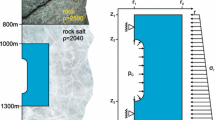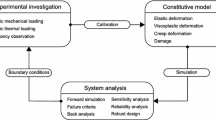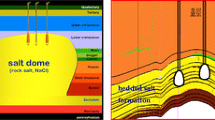Abstract
Exploring the material response of rock salt subjected to the variable thermo-mechanical loading is essential for engineering design of compressed air energy storage (CAES) caverns. Accurate design of salt caverns requires adequate numerical simulations which take into account the most important processes affecting the development of stresses and strains. To fulfill this objective, this paper presents a two-step simulation to analyze the thermo-mechanical behavior of rock salt in the vicinity of CAES caverns. In the first step, the changes in air temperature and pressure resulted from injection and withdrawal processes are estimated using an analytical thermodynamic model. Then, in the second step, the temperature and pressure variations obtained from the analytical model are utilized as the boundary condition for a finite element model of CAES cavern. An elasto-viscoplastic creep model is employed to describe the material behavior of rock salt. In the numerical section, a computational model to simulate the thermo-mechanical behavior of rock salt around the cavern is presented. Finally, the stability and long-term serviceability of the simulated cavern are evaluated considering two extreme loading scenarios: (1) low-pressure working condition and (2) high-temperature operation. Obtained results show that both stability and serviceability of the cavern are highly affected by the internal operating pressure. Dilatancy, damage propagation, tensile failure and increasing the rate of cavern closure are the unfavorable consequences of low-pressure working condition. Similarly, the increased creep rate due to the elevated temperature accelerates the volume convergence and subsequently endangers the serviceability of the system.















Similar content being viewed by others
References
Alkan H, Cin Y, Pusch G (2007) Rock salt dilatancy boundary from combined acoustic emission and triaxial compression tests. Int J Rock Mech Min Sci 44:108–119
Aubertin M, Gill D, Ladanyi B (1991) An internal variable model for the creep of rocksalt. Rock Mech Rock Eng 24(2):81–97
Bauer S, Beyer C, Dethlefsen F, Dietrich P, Duttmann R, Ebert M, Feeser V, Görke U, Köber R, Kolditz O, Rabbel W, Schanz T, Schäfer D, Würdemann H, Dahmke A (2013) Impacts of the use of the geological subsurface for energy storage: an investigation concept. Environ Earth Sci 70(8):3935–3943
Bérest P, Brouard B, Jafari MK, Sambeek LV (2007) Transient behavior of salt caverns-interpretation of mechanical integrity tests. Int J Rock Mech Min Sci 44:767–786
Bérest P, Brouard B, Jafari MK, Sambeek LV (2011) Thermomechanical aspects of high frequency cyclic in salt storage caverns. In: International gas union research conference, Seoul, Korea, 19–21 Oct
Bérest P, Djizanne H, Brouard B, Hévin G (2012) Rapid depressurization: Can they lead to irreversible damage? In: SMRI conference, Regina, Canada, 23–24 April
Bérest P, Brouard B, Djakeun-Djizanne H, Hévin G (2013) Thermomechanical effects of a rapid depressurization in a gas cavern. Acta Geotech 9(1):181–186
Brouard B, Frangi A, Bérest P (2011) Mechanical stability of a cavern submitted to high-frequency cycles. In: SMRI conference, Texas, USA, 18–19 April
Brouard B, Bérest P, de Greef V, Béraud J, Lheur C, Hertz E (2013) Creep closure rate of a shallow salt cavern at Gellenoncourt, France. Int J Rock Mech Min Sci 62:42–50
Carter NL, Hansen FD (1983) Creep of rocksalt. Tectonophysics 92(4):275–333
Code–Bright user’s guide (2010) Department of the Geotechnical Engineering and Geosciences of the Technical University of Catalonia (UPC)
Cortogino F, Mohmeyer KU, Scharf R (2001) Huntorf CAES: more than 20 years of successful operation. In: SMRI spring meeting, Orlando, 23–24 April, pp 351–357
Cosenza P, Ghoreychi M (1999) Effects of very low permeability on the long-term evolution of a storage cavern in rock salt. Int J Rock Mech Min Sci 36(4):527–533
Cristescu N (1987) Elastic viscoplastic constitutive equations for rock. Int J Rock Mech Min Sci Geomech 24(5):271–281
Cristescu N (1993) A general constitutive equation for transient and stationary creep of rock salt. Int J Rock Mech Min Sci Geomech 30(2):125–139
Cristescu N, Hunsche U (1998) Time effects in rock mechanics. Wiley, Chichester
Deng J, Yang Q, Liu Y (2014) Time-dependent behaviour and stability evaluation of gas storage caverns in salt rock based on deformation reinforcement theory. Tunn Undergr Sp Technol 42:277–292
Desai C, Varadarajan A (1987) A constitutive model for quasi-static behavior of rock salt. J Geophys Res 92:445–456
Desai C, Zhang D (1987) Viscoplastic model for geologic material with generalized flow rule. Int J Numer Anal Methods 11:603–627
Fuenkajorn K, Serata S (1993) Numerical simulation of strain-softening and dilation of rock salt. Int J Rock Mech Min Sci 30(7):1303–1306
Günther R, Salzer K (2007) A model for rock salt, describing transient, stationary, and accelerated creep and dilatancy. In: 6th conference on the mechanical behavior of salt—SALTMECH6, Hannover, Germany, 22–25 May
Hampel A, Schulze O (2007) The composite dilatancy model: a constitutive model for the mechanical behavior of rock salt. In: 6th conference on the mechanical behavior of salt—SALTMECH6, Hannover, Germany, 22–25 May
Heusermann S, Rolfs O, Schmidt U (2003) Nonlinear finite element analysis of solution mined storage caverns in rock salt using the LUBBY2 constitutive model. Comput Struct 81:629–638
Hou Z (2003) Mechanical and hydraulic behavior of rock salt in the excavation disturbed zone around underground facilities. Int J Rock Mech Min Sci 40:725–738
Hunsche U, Hampel A (1999) Rock salt—the mechanical properties of the host rock material for radio active waste repository. Eng Geol 52:271–291
Jafari MK, Brouard B, Bérest P (2011) Multi-cycle gas storage in salt caverns. In: SMRI conference, York, UK, 3–4 Oct
Khaledi K, Mahmoudi E, Datcheva M, König D, Schanz T (2016a) Sensitivity analysis and parameter identification of a time dependent constitutive model for rock salt. J Comput Appl Math 293:128–138
Khaledi K, Mahmoudi E, Datcheva M, Schanz T (2016b) Stability and serviceability of underground energy storage caverns in rock salt subjected to mechanical cyclic loading. Int J Rock Mech Min Sci 86:115–131
Kim HM, Rutqvist J, Ryu DW, Choi BH, Sunwoo C, Song WK (2012) Exploring the concept of compressed air energy storage (CAES) in lined rock caverns at shallow depth: A modeling study of air tightness and energy balance. Appl Energy 92:653–667
Kushnir R, Dayan A, Ullmann A (2012) Temperature and pressure variations within compressed air energy storage caverns. Int J Heat Mass Transf 55(21–22):5616–5630
Martín LB, Rutqvist J, Birkholzer JT (2015) Long-term modeling of the thermalhydraulicmechanical response of a generic salt repository for heat-generating nuclear waste. Eng Geol 193:198–211
Maton JP, Zhao L, Brouwer J (2013) Dynamic modeling of compressed gas energy storage to complement renewable wind power intermittency. Int J Hydrogen Energy 38(19):7867–7880
Minkley M, Muehlbauer J (2007) Constitutive models to describe the mechanical behavior of salt rocks and the imbedded weakness planes. In: 6th conference on the mechanical behavior of salt—SALTMECH6, Hannover, Germany, 22–25 May
Nazary S, Mirzabozorg H, Noorzad H (2013) Modeling time-dependent behavior of gas caverns in rock salt considering creep, dilatancy and failure. Tunn Undergr Sp Technol 33:171–185
Olivella S, Gens A (2002) A constitutive model for crushed salt. Int J Numer Anal Methods Geomech 26:719–746
Olivella S, Gens A, Carrera J, Alonso E (1996) Numerical formulation for a simulator (CODE_BRIGHT) for the coupled analysis of saline media. Eng Comput 13:87–112
Perzyna P (1966) Fundamental problems in viscoplasticity. Rec Adv Appl Mech 9:243–377
Pudewills A, Droste J (2003) Numerical modeling of the thermomechanical behavior of a large-scale underground experiment. Comput Struct 81(8–11):911–918
Raju M, Khaitan SK (2012) Modeling and simulation of compressed air storage in caverns: a case study of the Huntorf plant. Appl Energy 89(1):474–481
Rutqvist J, Kim HM, Ryu DW, Synn JH, Song WK (2012) Modeling of coupled thermodynamic and geomechanical performance of underground compressed air energy storage in lined rock caverns. Int J Rock Mech Min Sci 52:71–81
Schulze O, Popp T, Kern H (2001) Development of damage and permeability in deforming rock salt. Eng Geol 61:163–180
Serbin K, Ślizowski J, Urbańczyk K, Nagy S (2015) The influence of thermodynamic effects on gas storage cavern convergence. Int J Rock Mech Min Sci 79:166–171
Tryller H, Musso L (2006) Controlled cavern leaching in bedded salt without blanket in Timpa del Salto. In: SMRI spring meeting, Brussels, Belgium, 30 April–3 May
Wang T, Yan X, Yang H, Yang X, Jiang T, Zhao S (2013) A new shape design method of salt cavern used as underground gas storage. Appl Energy 104:50–61
Wang T, Ma H, Yang C, Shi X, Daemen J (2015) Gas seepage around bedded salt cavern gas storage. J Nat Gas Sci Eng 26:61–71
Waversik WR, Hanuum DW (1980) Mechanical behavior of New Mexico rock salt in triaxial compression up to 200 °C. J Geophys Res 85(B2):891–900
Weidinger P, Blum Hampel W A, Hunsche U (1997) Creep behavior of natural rock salt and its description with the composite model. Mater Sci Eng A 234–236:646–648
Xia C, Zhou Y, Zhou S, Zhang P, Wang F (2015) A simplified and unified analytical solution for temperature and pressure variations in compressed air energy storage caverns. Renew Energy 74:718–726
Xiong J, Huang X, Ma H (2015) Gas leakage mechanism in bedded salt rock storage cavern considering damaged interface. Petroleum 1(4):366–372
Yang C, Wang T, Li Y, Yang H, Li J, Qu D, Xu B, Yang Y, Daemen J (2015) Feasibility analysis of using abandoned salt caverns for large-scale underground energy storage in China. Appl Energy 137:467–481
Acknowledgments
This work was performed in the frame of the project ANGUS+ funded by the Federal Ministry of Education and Research (BMBF) under Grant No. 03EK3022C. The authors are grateful for this support.
Author information
Authors and Affiliations
Corresponding author
Additional information
This article is part of a Topical Collection in Environmental Earth Sciences on “Subsurface Energy Storage”, guest edited by Sebastian Bauer, Andreas Dahmke, and Olaf Kolditz.
Rights and permissions
About this article
Cite this article
Khaledi, K., Mahmoudi, E., Datcheva, M. et al. Analysis of compressed air storage caverns in rock salt considering thermo-mechanical cyclic loading. Environ Earth Sci 75, 1149 (2016). https://doi.org/10.1007/s12665-016-5970-1
Received:
Accepted:
Published:
DOI: https://doi.org/10.1007/s12665-016-5970-1




